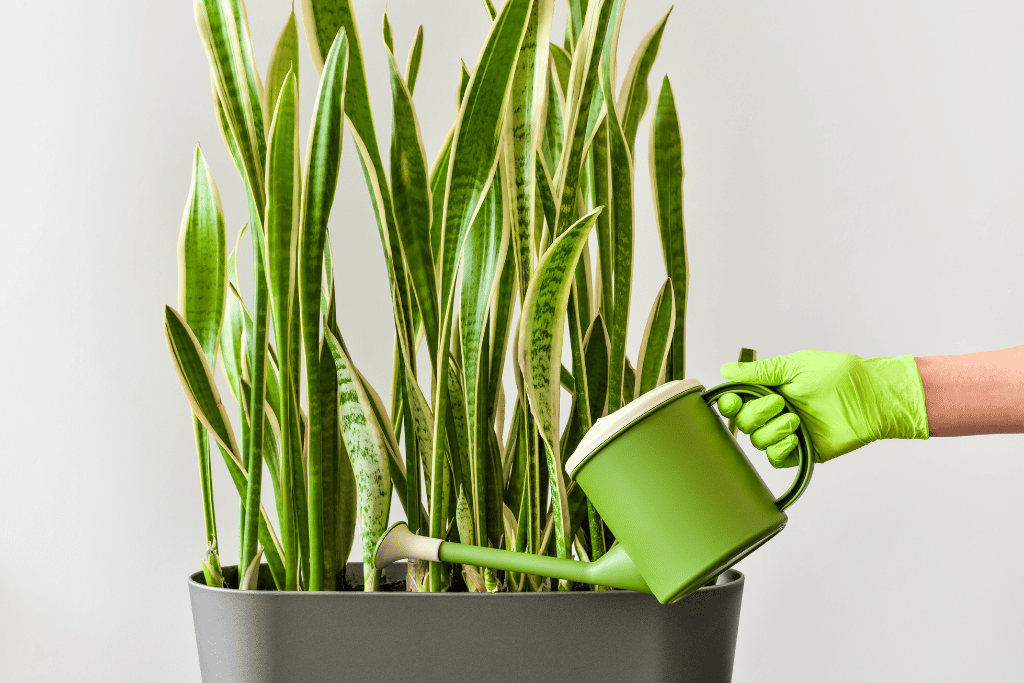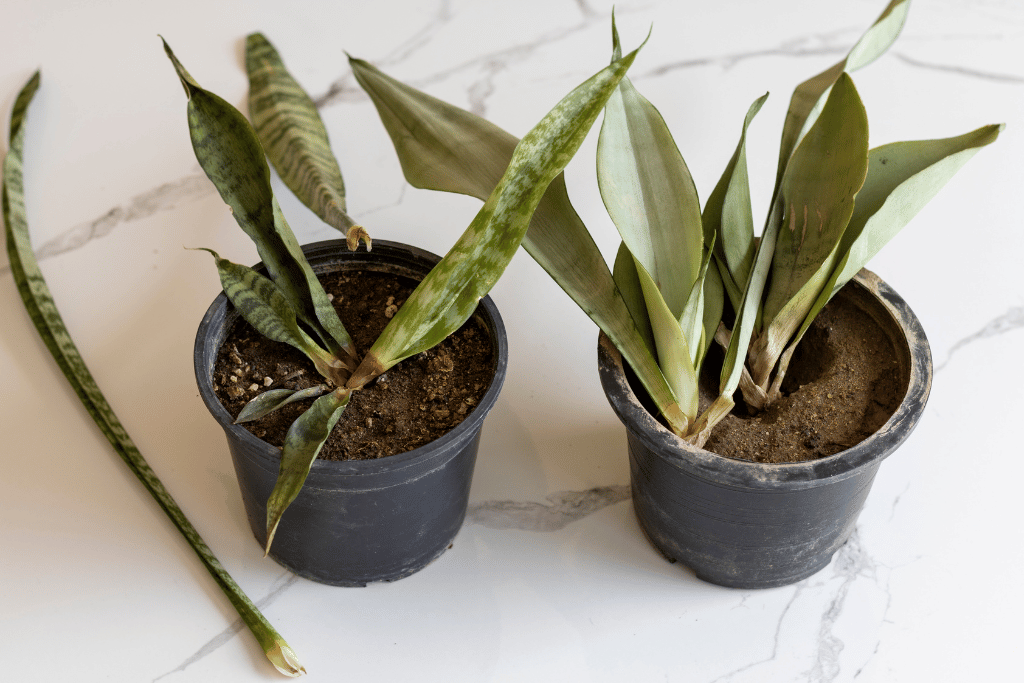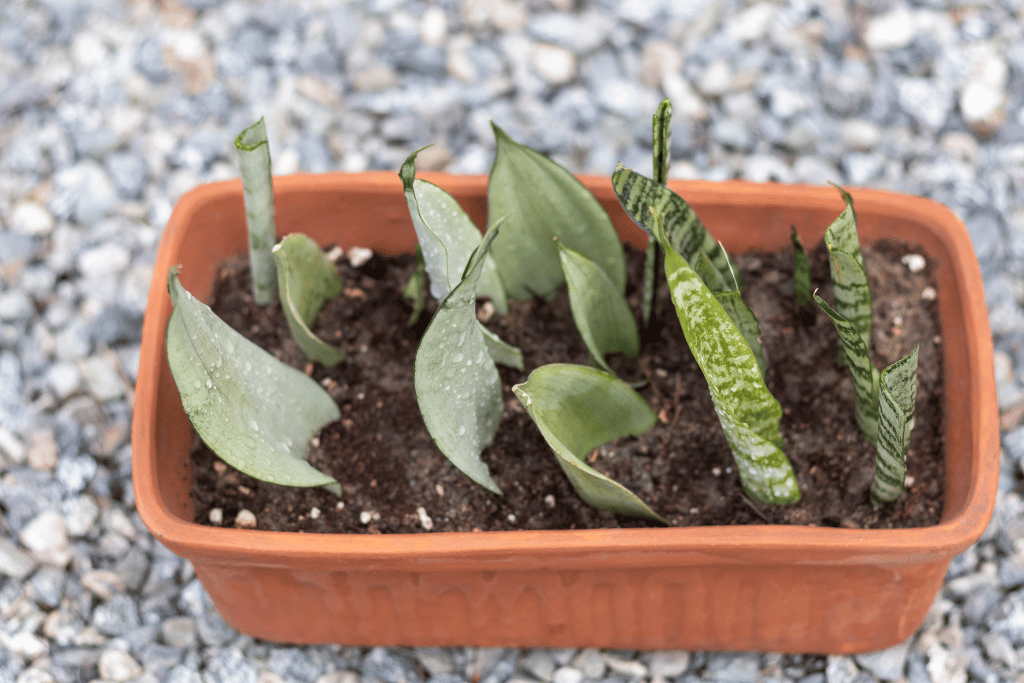
We’ve all been there, you bought some shiny new plant and we want to take care of it the best you can. All plants need water, right? So you water it regularly, then a little more, and a little more, until suddenly your plant is drowning!
Even with the best intentions, overwatering your plant could be deadly. This is especially true for an overwatered snake plant (Sansevieria). Marketed as being easy to care for, this species is a popular choice for any plant parent. However, like any houseplant species, the snake plant comes with unique difficulties and issues which are often overlooked.
Snake plants benefit from well-draining soil, and since they are native to tropical regions of Africa, they have adapted to tolerate long periods of drought. This means your snake plant only needs to be watered once almost all the soil in the pot is completely dry. If you are growing your snake plant outside, this might mean watering every other week depending on the temperature and sunlight your plant is exposed to. Indoors, you can probably go up to 3 weeks without watering your plant, depending on the size of the pot.
As mentioned before, snake plants can survive periods of drought better than periods of flooding, so overwatering your plant will cause many more issues than underwatering it!
Signs of an Overwatered Snake Plant
Like many issues your plant might face, an overwatered snake plant can be tricky to identify. This is because symptoms indicating an overwatered plant may also be caused by pests, temperature changes, or even underwatering! If you suspect your plant might be overwatered, check for the following issues to help you decide.

Yellow Leaves
Yellowing leaves are a tell-tale sign of an overwatered plant. This is often caused by a lack of oxygen in the roots (due to too much water) which starves the leaves of the nutrients they need. It is important to note that yellow edges of leaves can be normal in a snake plant if it is a variegated variety!

Soft, Mushy Leaves
If your snake plant has soft, mushy leaves, especially at the base, it may be overwatered. This can be an indication of root rot below the soil surface, beginning to move upwards in the plant and causing the leaves to rot. Regularly checking the base of your leaves just below the soil line by pinching gently will help you detect rot before it moves too far up your plant.

Soggy Soil
Soggy soil is a sure sign of an overwatered plant. If it has been a few days since watering and your soil is still wet, maybe even saturated with pools of water on top, your snake plant may be drowning! This could be caused by overwatering or just improper drainage in your pot. Check for clogged drainage holes and make sure excess water can run out of the pot after watering.

Wilting, Drooping Leaves
Snake plants are well-known and sought after for their striking, upright foliage. Wilting leaves can be a sign of overwatering, but also of underwatering or other issues. This symptom alone may not be an indicator of an overwatered plant, and if the soil seems okay and your leaves aren’t rotting, you likely have another issue on your hands.
Bad Smell
If your plant is sitting in standing water, it can sometimes develop a bad smell that you will eventually notice. This is caused by the rotting plant due to a lack of oxygen, and can sometimes smell like mildew (imagine damp laundry that has been sitting for a couple of days, but stronger). If you notice a smell coming from your snake plant, check the base of the leaves for rotting, and then consider digging into the soil to check the roots as well.

Root Rot
Root rot is a definite sign of overwatering, although it might be the last thing you notice in your plant. Monitoring root health is tricky since you aren’t likely to notice issues you can’t see! If you know your snake plant has been overwatered, checking and treating for root rot will help you save your plant. Gently remove your plant from the pot and brush off some soil. Healthy roots are plump, white, and firm to the touch or crisp when cut or snapped. Rotten roots will be brown or black, soft, and mushy to the touch.
How to Fix Overwatered Snake Plants
If, after reading all these signs of an overwatered snake plant you’ve determined your plant needs help, don’t worry! Your snake plant is likely not a lost cause, and with some simple changes and proper care, you can revive your plant to its full potential.
Repotting Snake Plant
One of the best things you can do for your overwatered plant is to repot it. This will give you a chance to inspect and treat any roots for root rot, remove rotting leaves, and give your plant fresh, new soil that isn’t waterlogged.
- Gently remove your snake plant from the pot it was in. Discard any old, wet soil and wash the pot thoroughly if you plan to reuse it.
- Remove soil from the roots carefully, taking care to not break any healthy roots. Trim off black, rotten roots and mushy, yellow leaves with a clean pair of sharp shears.
- If you like, you can rinse the roots to fully remove any wet soil and traces of rotten roots or disease that might be present.
- Place your plant back into the pot with fresh, new soil. Ensure your pot has sufficient drainage holes in the bottom.
- Water thoroughly, allowing any extra water to fully drain out of the pot.
- Place your snake plant in an area with bright, indirect sunlight while it recovers. Check the soil every week and water only when fully dry, about every 1-2 weeks depending on the conditions.

Propagating Snake Plant
If you believe your overwatered snake plant is too far gone and you just want to start fresh, you can do that too! Propagating snake plants is a great way to use the plant you have to grow one (or more) new plants, and can be done a couple of different ways:
- Division: if there is a small section of roots on your plant that are still healthy and not rotten, you can cut this portion off, including 1-2 leaves, and plant it into a smaller pot to start again.
- Leaf cuttings: you can take multiple cuttings from a healthy leaf on your snake plant. Place the cuttings in a small dish with the cut end in the water, and place them in a bright area out of direct sunlight. Refresh the water regularly (a few times a week) and rinse out the dish. Roots will form in 1-2 months and then your cutting can be planted into the soil to grow!

Read more about Snake Plant Disadvantages.
Final Tips
Remember, even though your plant needs water to survive, it is possible to have too much of a good thing! Overwatering is one of the most common issues snake plants have so don’t feel bad if your plant has been getting a bit too much attention from your watering can. By taking immediate action after noticing the signs and symptoms mentioned above, you can rescue your drowning snake plant and have it healthy and happy again in no time at all!
Frequently Asked Questions (FAQ)
Can you save an overwatered snake plant?
Yes! Even though your overwatered snake plant may seem like a lost cause, you can almost always save at least part of your plant. Start by assessing the damage and then use the tips above to salvage what you can and start fresh, your plant will thank you for not giving up!
Will a snake plant repair itself?
Unfortunately not. When a snake plant is damaged, either through mechanical injury or issues like root rot, it won’t heal itself without your intervention. Damaged leaves and roots can be safely removed when proper measures are taken, allowing your plant the space and energy it needs to produce new, healthier growth.
Can you reverse overwatering?
If you suspect you may have overwatered your plant, there are a few things you can do. If you don’t want to disturb your plant, your best choice is to stop watering to allow the soil to dry. If possible, place your plant in a warm, sunny location to help speed up the drying process. If you worry that your plant is beyond saving, you could take a cutting of a leaf to propagate so you don’t lose the whole plant.
How do I know if my snake plant is dying?
If you see a drastic increase in the number of soft, yellow, or brown leaves on your snake plant, this is a good indication that your plant is stressed and possibly dying. Snake plants are relatively hearty and can be slow to react to issues, but if left alone at this stage they will eventually die.



